Are you looking for the best cat food to keep your feline friend healthy and happy? With so many options available in the market, it can be overwhelming to choose the right one. But fear not, because we have got you covered.
In this article, we will guide you through the top ingredients to look for in high-quality cat food that will provide your cat with the necessary nutrients and keep them thriving. If you want your cat to have a shiny coat, strong muscles, and a healthy immune system, then you need to focus on the right ingredients.
High-quality cat food should have a rich source of protein, healthy fats, and essential nutrients that will promote overall well-being. And let’s not forget to avoid artificial additives and preservatives that can harm your cat’s health. With our helpful guide, you can confidently choose the best cat food that will provide your furry friend with everything they need to stay healthy and happy.
Key Takeaways
– Whole protein sources like chicken or fish should be the first ingredient
– Omega-3 and omega-6 fatty acids are essential for healthy skin, coat, immune system, and brain function
– Cat food should be free from fillers and artificial additives
– Wet cat food is an excellent source of hydration
Protein Sources
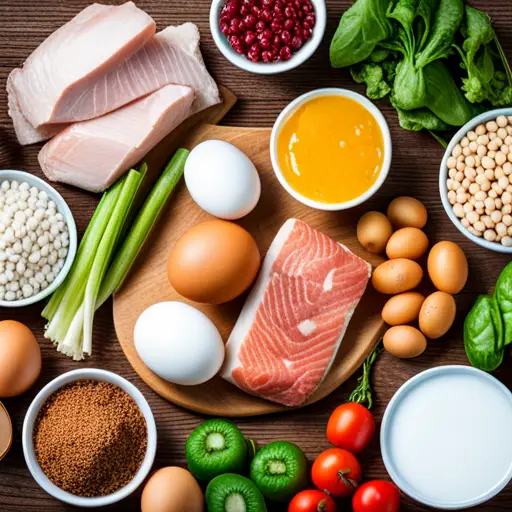
You’ll want to make sure your kitty is getting enough protein from sources like chicken, fish, or turkey to keep them healthy and active. Different types of protein sources for cats are important because they each provide unique benefits.
For example, chicken is a lean protein source that helps maintain strong muscles, while fish provides omega-3 fatty acids that support healthy skin and a shiny coat.
But it’s not just about the quantity of protein in your cat’s food, it’s also about the quality. The importance of protein quality in cat food can’t be overstated. High-quality protein sources are more easily digestible and contain essential amino acids that your cat needs to thrive.
Look for cat foods that list whole protein sources, like chicken or fish, as the first ingredient to ensure your furry friend is getting the best nutrition possible.
Healthy Fats
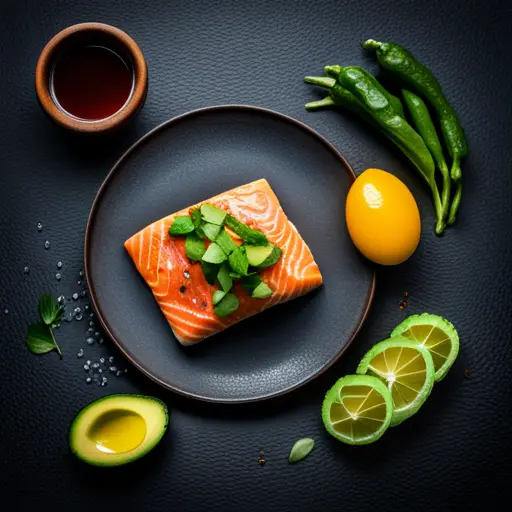
You might not think much about fats in your cat’s diet, but they play an important role in keeping your feline friend healthy. Omega-3 and omega-6 fatty acids are essential for maintaining healthy skin and a shiny coat, as well as supporting your cat’s immune system.
Some of the top sources of healthy fats in cat food include salmon, flaxseed, and chicken fat.
Omega-3 and Omega-6 Fatty Acids
With a healthy balance of Omega-3 and Omega-6 fatty acids, your feline friend’s coat will shine brighter than a diamond in the sun. These two essential fatty acids are crucial for maintaining healthy skin and coat, as well as supporting your cat’s immune system and brain function.
Omega-3 fatty acids, such as those found in fish oil, are particularly important for reducing inflammation and promoting heart health in cats. When looking for high-quality cat food, make sure to check the sources of omega-3 for cats. Some common sources include fish oil, flaxseed, and chia seeds.
It’s also important to consider the balance between omega-3 and omega-6 fatty acids in your cat’s diet. While both are important, too much omega-6 can lead to inflammation and other health issues. A ratio of 5:1 or lower of omega-6 to omega-3 is ideal for cats.
By providing your cat with a diet rich in these essential fatty acids, you can help ensure they stay healthy and happy for years to come.
Benefits of Healthy Fats for Cats
Healthy fats are essential for your feline friend as they provide numerous benefits. They play a crucial role in promoting healthy skin and coat, making your cat look shiny and healthy.
Healthy fats also support immune system function, helping your cat fight off diseases and infections. In addition, they aid in brain function, ensuring that your cat stays alert and active.
Sources of healthy fats for cats include fish oils, flaxseeds, and chicken fat. It’s important to ensure that your cat’s diet contains the recommended daily intake of healthy fats, which is about 20-30% of their daily calorie intake.
Feeding your cat a diet that’s rich in healthy fats will not only provide numerous health benefits but also keep your furry friend happy and healthy. So, make sure to choose a high-quality cat food that contains the right balance of healthy fats to keep your cat in tip-top shape!
Top Sources of Healthy Fats in Cat Food
Oh, so you think your cat can get all the healthy fats they need from a regular bag of kibble? Think again, my friend. Ain’t nobody got time for that when there are delicious sources of omega-3 and omega-6 fatty acids like salmon and chicken fat!
These healthy fat alternatives not only provide essential nutrients for your cat’s overall health and well-being, but they also have a significant impact on weight management.
Salmon is a top source of healthy fats in cat food, as it’s rich in omega-3 fatty acids that support healthy skin and coat, reduce inflammation, and promote brain and eye development.
Chicken fat is another great option, as it’s a rich source of omega-6 fatty acids that help maintain healthy skin and coat, support immune function, and promote a healthy metabolism.
Incorporating these healthy fats into your cat’s diet can help keep them at a healthy weight while providing them with the nutrients they need to thrive.
Essential Nutrients
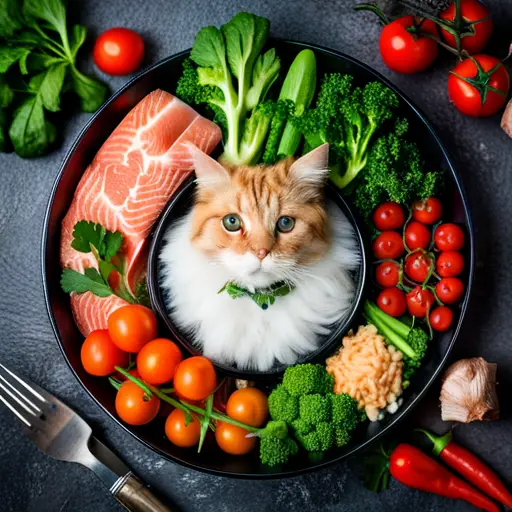
When it comes to feeding your cat, it’s important to ensure they’re getting all the essential nutrients they need to thrive. Essential nutrients are those that a cat’s body can’t produce on its own and must be obtained through their diet.
Some of the top essential nutrients to look for in cat food include protein, vitamins, minerals, and fatty acids. Each of these nutrients has different benefits for your feline friend.
By choosing cat food that’s rich in essential nutrients, you can help support your cat’s overall health and well-being.
Importance of Essential Nutrients in Cat Food
You can’t afford to ignore the importance of essential nutrients in your cat’s food if you want to keep them happy and healthy.
A balanced diet is essential for your cat’s overall health and wellbeing. Without the right balance of nutrients, your cat may develop health problems that could have been prevented with proper nutrition.
Some of the health risks associated with nutrient deficiencies in cats include malnutrition, weakened immune system, and even organ failure.
To ensure that your cat gets all the essential nutrients they need, look for high-quality cat food that contains a balanced blend of proteins, carbohydrates, fats, vitamins, and minerals. A good cat food should also be free from fillers and artificial additives that could harm your cat’s health in the long run.
By choosing the right cat food, you can help your feline friend live a happy and healthy life.
Top Essential Nutrients to Look for in Cat Food
Feeding your furry friend with a diet packed with all the necessary nutrients is crucial for their optimal health and happiness – no compromises! Two of the most essential nutrients that you should look for in your cat’s food are hydration and carbohydrates.
Hydration is crucial because your cat’s body is made up of 70% water, and they need to replenish the fluids they lose through urination, panting, and sweating. Cats may not drink enough water on their own, which is why it’s important to choose cat food that contains a high moisture content. Wet cat food is an excellent source of hydration as it contains up to 80% water. You can also add water to dry cat food to increase your cat’s water intake.
It’s important to ensure that your cat is always hydrated as dehydration can lead to kidney problems, urinary tract infections, and even death.
Carbohydrates provide energy to your cat and are essential for maintaining their overall health. They help fuel your cat’s body and provide them with the energy they need to play, hunt, and explore. However, not all carbohydrates are the same, and it’s essential to choose cat food that contains high-quality carbohydrates.
Whole grains, such as brown rice and oats, are excellent sources of carbohydrates for cats as they provide fiber and other essential nutrients. On the other hand, processed grains, such as corn and wheat, can cause digestive problems and should be avoided. By choosing cat food that contains the right carbohydrates, you can ensure that your cat stays healthy and active.
Benefits of Essential Nutrients for Cats
Ensuring that your feline friend receives essential nutrients will lead to a healthier and happier life. These nutrients are crucial for the proper functioning of their body systems, including digestive health and immune function.
With the right balance of vitamins and minerals, your cat will be able to maintain a strong immune system, ward off diseases, and support their overall well-being. When it comes to digestive health, essential nutrients play a key role in maintaining gut health and preventing digestive issues such as constipation and diarrhea.
Vitamins and minerals such as fiber, prebiotics, and probiotics can promote healthy digestion and keep your cat’s gut microbiome in balance. Additionally, essential nutrients are also important for supporting your cat’s immune function and ensuring they stay healthy and happy for years to come.
So, make sure to choose high-quality cat food that contains all the essential nutrients your furry friend needs for optimal health.
Artificial Additives and Preservatives
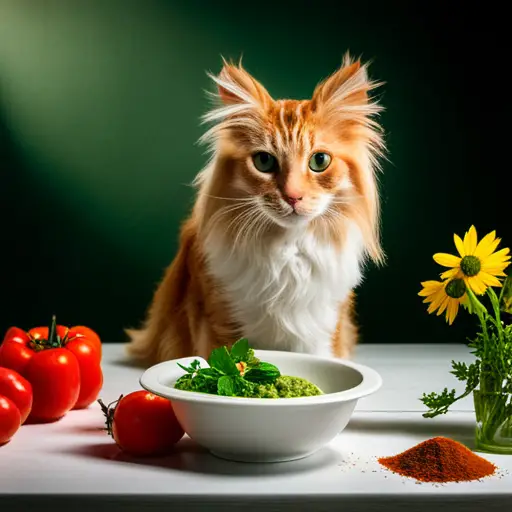
Avoiding artificial additives and preservatives is important when choosing high-quality cat food, as they can negatively impact your pet’s health in the long run. Some common preservatives to avoid include BHA, BHT, and ethoxyquin. These additives have been linked to cancer, liver and kidney problems, and allergic reactions in cats.
Instead, look for natural alternatives to artificial additives, such as vitamin E and rosemary extract, which can help preserve the food without causing harm to your furry friend.
In addition to preservatives, many cat foods contain artificial additives such as colors, flavors, and sweeteners. These additives are often added to make the food more appealing to humans, but they can lead to health problems in cats.
For example, artificial flavors and sweeteners can cause digestive issues and allergies, while artificial colors have been linked to cancer and hyperactivity in pets.
It’s best to choose a cat food that is free from artificial additives and preservatives, so you can be sure that you are providing your pet with the highest quality nutrition possible.
Reading Cat Food Labels
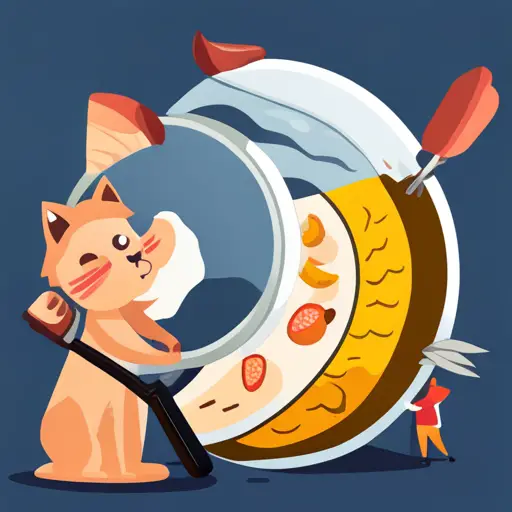
When it comes to choosing the best cat food for your furry friend, it’s crucial to understand cat food labels. By reading and analyzing the labels, you can make informed decisions about the ingredients and nutrients in the food.
With a little guidance, you can easily choose high-quality cat food that meets all of your cat’s nutritional needs.
Understanding Cat Food Labels
You’ll find it helpful to take a closer look at cat food labels to ensure you’re selecting the best option for your furry friend. Understanding cat food labels and decoding cat food ingredients can be a bit overwhelming, but it’s worth the effort to ensure your cat is getting the nutrition they need.
Here are five things to keep in mind when reading cat food labels:
– Look for whole protein sources: Cats are obligate carnivores, meaning they require a diet high in animal protein. Look for labels that list specific meat sources (e.g. chicken, turkey, salmon) as the first ingredient.
– Avoid fillers and by-products: Fillers like corn, wheat, and soy provide little nutritional value and can be hard for cats to digest. By-products, such as chicken meal or meat by-products, are lower quality protein sources and can include less desirable parts of the animal.
– Check the guaranteed analysis: This section lists the minimum amount of protein and fat, as well as the maximum amount of fiber and moisture, in the food. Ensure these values meet your cat’s individual needs.
– Consider the brand’s reputation: Research the brand’s history and quality control measures to ensure they prioritize the health and safety of their products.
– Pay attention to serving sizes: The label may list the nutrient content per serving, but it’s important to ensure you’re feeding your cat the appropriate amount based on their age, weight, and activity level.
Incorporating these tips into your cat food label reading routine can help you make informed decisions about your cat’s diet. Remember, feeding your cat high-quality food is an act of love and can lead to a happier and healthier furry friend.
How to Choose High-Quality Cat Food Based on Labels
Congratulations, you’ve decided to treat your feline friend to a gourmet feast by selecting a label that prioritizes real meat as the primary ingredient. However, choosing high-quality cat food based on labels can be a daunting task, with so many brands and claims to navigate.
To avoid common pitfalls, it’s important to understand labeling regulations and what to look for on the label. The first thing to keep in mind is that the ingredients are listed in order of weight, so the first ingredient is the most abundant. Look for a label that lists a high-quality source of protein as the first ingredient, such as chicken, turkey, or fish. Avoid labels that list ambiguous ingredients like ‘meat by-products’or ‘animal digest,’as they can come from any animal and may not be of good quality.
Additionally, make sure the label meets AAFCO (Association of American Feed Control Officials) standards, indicating that it provides complete and balanced nutrition for your cat. With these tips in mind, you can confidently choose high-quality cat food that will keep your feline friend healthy and happy.
Tips for Finding the Best Cat Food for Your Feline Friend
To ensure your furry companion is getting the best nutrition possible, it’s important to consider their unique needs and preferences when selecting their daily diet. Nutritional requirements vary depending on your cat’s age, weight, and health condition. Consult with your veterinarian to determine the right balance of protein, fat, and carbohydrates for your pet.
When shopping for cat food, it’s also important to do brand comparison. Look for reputable brands that have been in the market for a long time and have established a good track record in terms of quality and safety. Check the ingredients list and avoid products that contain fillers, by-products, and artificial preservatives.
Always choose high-quality cat food that meets your pet’s nutritional requirements and taste preferences. Your furry friend deserves nothing but the best!
Conclusion
Congratulations, you’ve learned about the top ingredients to look for in high-quality cat food! By ensuring that your feline friend is consuming adequate protein sources, healthy fats, and essential nutrients, you’re providing them with the necessary building blocks for optimal health and longevity.
Did you know that, according to a recent survey, 70% of cat owners are willing to pay more for high-quality cat food? This statistic highlights the importance that pet owners place on the well-being of their furry companions and the growing trend towards premium pet nutrition.
By investing in your cat’s health, you’re not only providing them with a better quality of life but also potentially reducing costly veterinary bills down the line. So, keep these ingredients in mind when shopping for your cat’s food and give them the best chance at a happy and healthy life.
